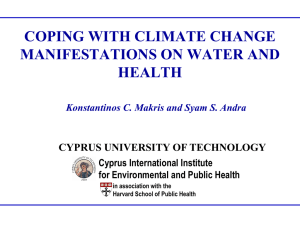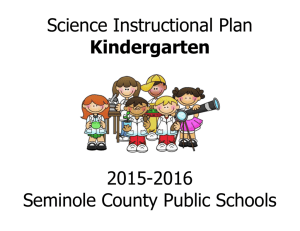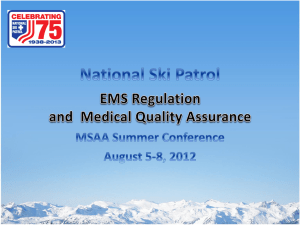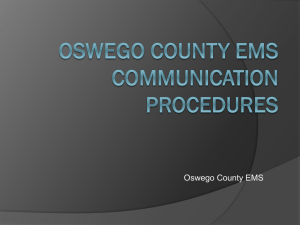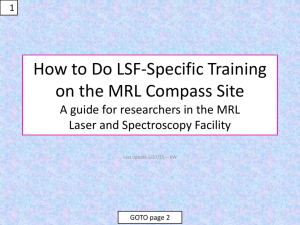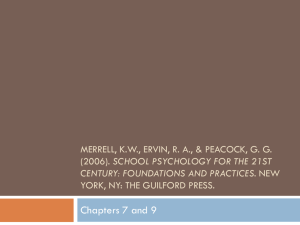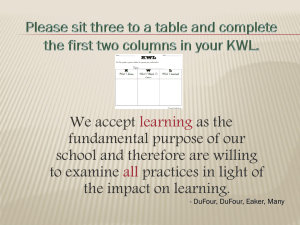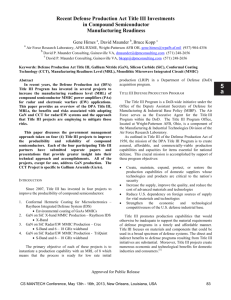Day1_MTs - Re-Inventing Schools Coalition
advertisement
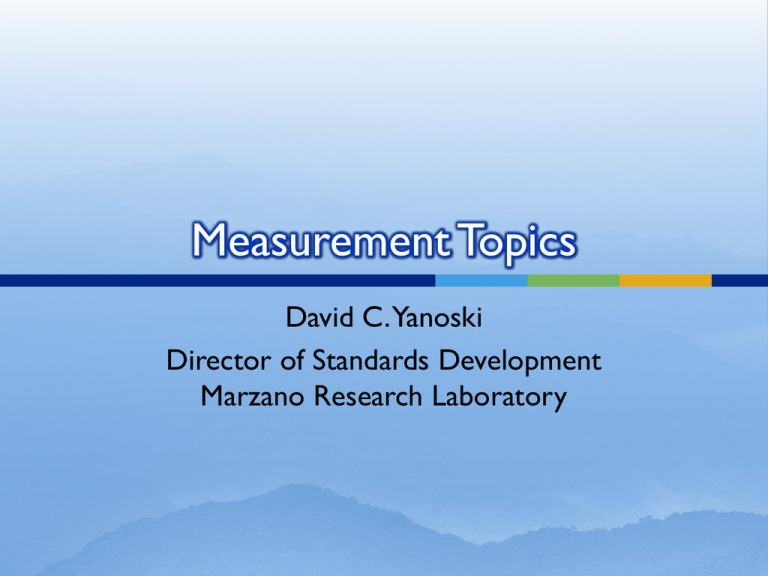
Measurement Topics David C.Yanoski Director of Standards Development Marzano Research Laboratory Our Project… The Scale 4 In addition to exhibiting level-3 performance, in-depth inferences and applications that go BEYOND what was taught in class 3 No major errors or omissions regarding any of the information and/or processes (SIMPLE OR COMPLEX) that were explicitly taught 2 No major errors or omissions regarding the SIMPLER details and processes BUT major errors or omissions regarding the more complex ideas and processes 1 With HELP, a partial knowledge of some of the simpler and complex details and processes 0 Even with help, no understanding or skill demonstrated The rubric or scale - simplified Learning above and beyond what was taught 4.0 3.5 The Learning Goal – What you expect the student to know or be able to do 3.0 2.5 The Simpler Stuff – Foundational knowledge, partial knowledge or simpler procedures 2.0 1.5 The Student Needs Help to perform 1.0 .5 0.0 The Student can’t do anything The MRL Standards Scale Document Score 4.0 Score 3.0 The expected learning Score 2.0 Score 1.0 Score 0.0 Strand: Government (Broad Category of Learning) Measurement Topic: Checks and Balances (Specific Learning or Skill being measured) Grade: 8 (Grade Level) In addition to Score 3.0, in-depth inferences and applications that Sample Tasks or Daily Learning Objective go beyond what was taught. Classroom activities or assessments used to demonstrate student progress or Daily Learning Goals Demonstration of learning beyond what was taught 3.5 In addition to score 3.0 performance, in-depth inferences and applications with partial success. The student: describes the role of the Supreme Court in checking the power and authority of the Legislative and Executive Branches Element: Grade level specific subdivision of Measurement Topic The student exhibits no major errors or omissions. 2.5 No major errors or omissions regarding 2.0 content and partial knowledge of the 3.0 content There are no major errors or omissions regarding the simpler details and processes as the student: recognizes or recalls specific terminology such as: o judicial review, unconstitutional Vocabulary essential to understanding the Score 3.0 Learning goal performs basic processes, such as: o recognizing and recalling accurate statements about the role of the Supreme Court in checking the power of the Legislative and Judicial branches Score 2.0 element: simpler version of the Score 3.0 content at a lower taxonomic level However, the student exhibits major errors or omissions regarding the more complex ideas and processes. 1.5 Partial knowledge of the 2.0 content but major errors or omissions regarding the 3.0 content With help, a partial understanding of some of the simpler details and processes and some of the more complex ideas and processes. 0.5 With help, a partial understanding of the 2.0 content but not the 3.0 content Even with help, no understanding or skill demonstrated. 5 easy(?) steps to writing and using Standards Scales 1. 2. 3. 4. 5. Unpack Standards/Identify Essential Standards/Organize /Write Measurement Topics Specify expected learning by writing Score 3.0, and write sample tasks to further specify content Identify steps towards the mastery of the content by writing Score 2.0, write sample tasks to further specify content Decide on 4.0, write if necessary Pilot and Use! Design Assessments, Assess student learning, Report student progress Summer Scale Development Institute Monday Measurement Topics Tuesday Score 3.0 Sample Tasks Wednesday Score 2.0 Sample Tasks Thursday Score 4.0? Friday FASBG Next Steps Revision and Feedback Phase MRL Revision • MRL reviews and provides feedback on scales • IVC to share comment s and answer questions • Chaffey teams review feedback Chaffey and Revision revise scales • Return to MRL Final Product • MRL creates final draft • Editing and format • MRL writes primer/h andbook for scales USE! Teachers use scales to assess student progress and learning Writing Measurement Topics Measurement Topic vs. Daily Learning Objective Measurement topic More general Subdivision of Standard Overall topics of learning Written using similar words and structure Limited to 25 to 35 for each course Curricular in nature What you want the kid walking out of class knowing or being able to do Daily Learning Objective More Specific Subdivision of Measurement Topic Steps towards achieving the measurement topic Written using similar words and structure No limit Instructional in nature The steps a kid goes through to get to their goal Standard Measurement Topic Daily Learning Objective Daily Learning Objective Daily Learning Objective Measurement Topic Measurement Topic Daily Learning Objective Daily Learning Objective Daily Learning Objective Daily Learning Objective Daily Learning Objective Daily Learning Objective Writing Measurement Topics Based on your content knowledge and expertise, the Essential Measurement Standards, and the California Content Standards… …What are the 25-35 essential topics that all students have to know and master in your subject area and at your grade level? Content/ Strand EMS EMS Measurement Topic Measurement Topic EMS Measurement Topic Using the Essential Measurement Standards to write Measurement Topics Use the EMS and identify the topic of each standard EMS – Students write geometric proofs, including proofs by contradiction Topic – Geometric Proofs (no verb!) When the standard identifies 2 or more different pieces of learning or skill, break these into 2 or more topics EMS - Understand how the forces of nationalism developed in the Middle East, how the Holocaust affected world opinion regarding the need for a Jewish state, and the significance and effects of the location and establishment of Israel on world affairs Topics: Nationalism in the Middle East Arguments for/ against a Jewish State Effects of the establishment of Israel Content Area: Grade Level/Course: Content Topic/Strand: What do you expect the student to know about this topic? Essential Measurement Standard Essential Measurement Standard Essential Measurement Standard Essential Measurement Standard Are you asking the student to know or do more than one thing in each expectation? If you are, break the expectation down into 2-4 smaller pieces. These are your Measurement Topics. Measurement Topics…The Rules For each course, limit the number of measurement topics to 25-35 You will write a scale for each of these topics Each Measurement Topic will assess only one specific piece of information or skill – Unidimensional All content contained within a MT should covary – as ability in one increases, so does the ability in others Why only 25-35? There is so much more important stuff! One of the main problems in using standards is that they identify too much content – more topics defeats the purpose Experience with other groups has shown that scales with more topics just don’t get used Students can’t master any more than about 25-35 topics in a year. Having more topics becomes covering content for content’s sake, not teaching for learning Nice to Know Supplemental Essential Standards Benchmarks can be divided into 3 categories… Heflebower, based on O’Connor IF YOU HAVEN’T WRITTEN THE ESSENTIAL MEASUREMENT STANDARDS… Forward design Start with a blank slate. Use content knowledge and expertise to list topics of study for each course Categorize them as Essential, Supplemental or Nice to know Choose the most important 25-35 Essentials or Supplementals to measure Go back to the Core Standards and make sure that you are staying within the bounds of the state standards Backward Design Start with the Core standards and identify the topics that are already there Group like or covarying skills or knowledge together and assign a name to it Categorize the groupings as Essential, Supplemental or Nice to know Choose 25-35 essential or supplemental groupings Content Area: Grade Level/Course: Content Topic/Strand: These are your Measurement Topics. Your Task… Create a list of Measurement Topics for each course Keep in mind that the list will change! It doesn’t have to be perfect!
